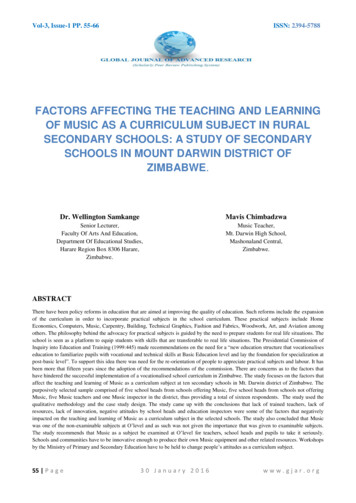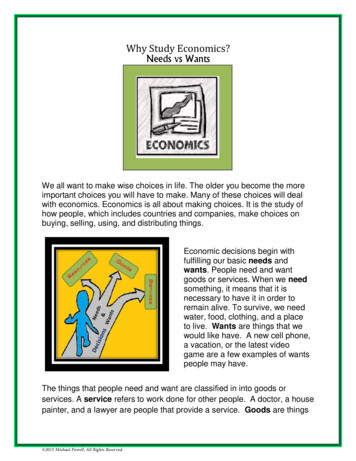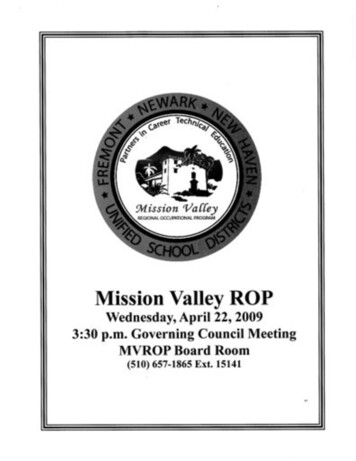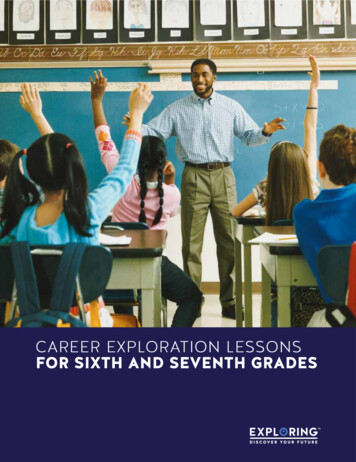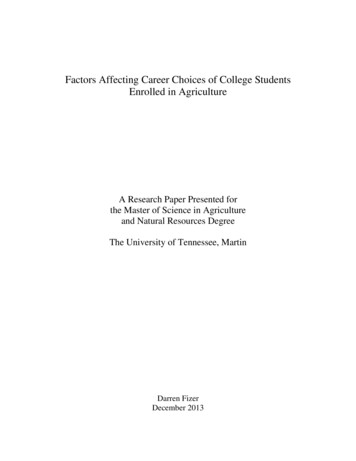
Transcription
Factors Affecting Career Choices of College StudentsEnrolled in AgricultureA Research Paper Presented forthe Master of Science in Agricultureand Natural Resources DegreeThe University of Tennessee, MartinDarren FizerDecember 2013
AcknowledgementsI would like to thank the entire agriculture department for all of their support throughout mycareer. I would especially like thank Dr. Barbara Darroch, Dr. Joey Mehlhorn, and Dr. ScottParrott for all the extra time they spent with me during my classes and research project. Thesethree professors have been positive role models and have always been there if I needed anything.I would also like thank my family and friends for always supporting during academic career atUT Martin. They have always been my motivation, and I will forever appreciate everything theyhave done for me.ii
AbstractChoosing the right career path is becoming more and more important for young students today.Students have to take into account many things when choosing a career and college major. Manyfactors can influence a student’s decision, including parents, coaches, religious figures, or anyrole models in a student’s life. Participation in agriculture clubs such as FFA and 4-H can alsohave an effect on students’ career choices.The objectives of this research study were to determine what factors affect agriculture students’choice of career path. A questionnaire was developed to examine areas of interest and attributesthat may have influenced students when choosing a career path. The questionnaire wascompleted by 128 students in the freshman studies classes of The University of Tennessee atMartin who plan to major in Agriculture. Chi-square tests were used to examine relationshipsamong study factors.According to this survey, students are most influenced by family when choosing a major; 22%chose family as the most important factor influencing their choice of major. However, 21% ofthe students chose “a career that is personally rewarding” and 20% chose “FFA/4-H experience”as the most important factors affecting their choice. FFA played a bigger role in choosing amajor than 4-H. Farming background and the size of schools did not play a role in choosing amajor. However, students with a farming background were more likely to plan on working inproduction agriculture than students without a farm background. The students who completed thequestionnaire had a positive outlook on their career. Students believe their projected careers willmake a positive impact on the world. Students also believe that there are excellent careeropportunities in agriculture.iii
Table of ContentsAbstract . iiiTable of Contents . ivChapter 1: Introduction . 1Research Objectives . 2Chapter 2: Literature Review . 4History . 4Recent Decades . 4Popular Career and Major Fields . 6Careers in Agriculture . 6Factors Influencing Choice of Career and Major . 7Interest in Field . 7Academic Ability and Aptitude . 7White Collar vs. Blue Collar . 8Personality . 9Influential People . 9Family Business . 10Economic Stability . 10Gender . 11Race . 11Outside Factors . 12Factors Affecting Career Selection in Agriculture . 12FFA and 4‐H . 13Changes in Major Fields . 13Tools Used for Career Choices . 14Recruiting . 14Employment After Graduation . 15Chapter 3: Methodology . 17Survey Population . 17Data Analysis . 17Chapter 4: Results and Discussion . 19Survey Results for each Objective. 19Objective 1: Did FFA or 4H influence students on choosing a major? . 19Objective 2: How important are classes/job skills to a student’s area of study? . 23Objective 3: What was the most influential factor in choosing a major?. 28iv
Objective 4: Did the Size of the Students School play a role in choosing a major? . 28Objective 5: Did growing up on a farm play a role in choosing a major? . 31Objective 6: Do students believe they will work in degree area? . 31Chapter 5: Conclusion . 33References . 35Appendix A IRB Letter from University of Tennessee at Martin . 38Appendix B Survey Questions . 39v
List of FiguresFigure 1. Number of freshman agriculture students in each major concentration at UT Martin,August 2013. 20Figure 2. Number of freshman agriculture students in each predicted career path. . 20Figure 3. Percentage of freshman agriculture students at UT Martin with ACT scores in theindicated ranges. . 21Figure 4. Percentage of freshman agriculture students at UT Martin who participated inFFA and 4-H . 21Figure 5. Percent of students who indicated that participation in FFA or 4-H influenceor did not influence their choice of major . . 22Figure 6. Number of freshman agriculture students in FFA/4-H grouped by projectedcareer path. 22Figure 7. Percent of freshman agriculture students in FFA/4-H grouped by projectedcareer path. 24Figure 8. The most important factor that influenced a student’s choice of major,as indicated . 29Figure 9. Career choices indicated by freshman agricultural students, expressed as apercent . 29Figure 10. Participation in FFA or 4-H in high school, expressed as a percent within each . 30Figure 11. Percent of freshman agriculture students who grew up on a farm and who. 32Figure 12. Percent of agriculture students who grewup on a farm or did not grow upon a farm . 32vi
LIST OF TABLESTable 1. Means and standard deviation for importance rankings of college classes, grouped byprojected career paths of freshman agriculture students. . 25Table 2. Means and standard deviations for importance rankings of college classes, grouped byprojected career paths of freshman agricultural students . 26Table 3. Means and standard deviations for importance rankings of job skills, grouped byprojected career paths of freshman agriculture students. . 27vii
Chapter 1: IntroductionCollege students choose their job fields for many reasons. The factors that affect this decisioninclude family, passion, salary,and past experiences. In addition to these factors, race and gendercan also affect what field a student may choose. Some professions have greater percentages of acertain gender or race. Another thing that plays a big role in a student’s decision of what field tostudy is the people or role models in his or her life. These role models can include a parent,teacher, or a recent employer.When students are choosing a career, they may not have all the information about the job theyare pursuing. The job may involve more math or science than students are prepared to study.Students may like one aspect of a certain job and not understand what other aspects come withthat profession. For example some students may want to be veterinarians because they enjoybeing around animals, but students may not realize how much school work is required to becomea veterinarian. Also, students may not be open to all jobs in their area of interest.Over time, certain job fields have peaked in numbers versus other job fields; this can form apattern.Tools that can help students in their decision for certain career paths include career fairs,job shadowing, or internships. These tools can expose students to more career fields or areaswithin a certain field that a student did not know about.Choosing a career path is a huge part of a young man or woman’s life. The career pathstudents choose will affect how they will live the rest of their life. A lot of students go throughcollege without knowing what career path they want. Before students can pick a career path theyneed to experience what that career is like and what it involves.1
There are many careers in agriculture from which students may choose. There are greatopportunities for advancement and job placement in the agricultural field (Thiesse, 2012).Careers in the agricultural field include extension agents, crop production services, andagricultural communications.Research ObjectivesThis research study was developed to examine factors that affect agriculture students whenchoosing a college major and career.1) The first objective of this research project was to determine if FFA or 4-H influenced studentswhen choosing a major. Students who join FFA or 4-H want to get more involved in agriculture.These organizations show students the many opportunities that agriculture has to offer,such asteaching students where food comes from and how it is processed, or gaining an understandingof the growing economy and how it affects agriculture. Students in 4-H or FFA are able tocompete against other students in competitions such as soil judging, livestock showing, publicspeaking, and meat judging.2) The second objective of this research project was to determine students perceptions of therelationship of classes and skills needed to be successful in a career. Students oftenunderestimate the importance of job skills and classes that are involved in career paths. Forexample, customer service can be underrated by some students when starting out. However,customer service is vital to every business in the nation and can contribute to the success orfailure of a business.3) Thirdly, this research project examined factors that most influence students when choosing amajor or a career. There are many factors that have an influence on students today, includingfamily, friends, and mentors. Students may also choose careers because they are personally2
rewarding, there is a growing need for jobs in a certain job field, or there is potential for a greatincome.4) The fourth objective of this research paper was to determine if the size of a student’s schoolplays a role in choosing a major or career. Larger high schools have more programs and clubs tooffer than others, giving students more opportunities. Smaller schools are often located in morerural areas, which may lead students to an agricultural career path or major.5) The fifth objective of this research paper was to determine if growing up on a farm played afactor in choosing a major. Many students who grow up on a farm want to go into an agriculturalcareer, whether they go back to farming or find a job in a different area of agriculture. Growingup on a farm may also have a negative effect on students. Students may dislike farm life andchoose a different career path.6) Finally, the last objective of this research paper was to determine whether students plan towork in the field of study in which they have majored. There is always a group of students whomajor in a certain degree area and end up on another career path. Students may not know exactlywhat career path to follow, and they may not decide on a career until they enter the workforce.For example, a student with a degree in agribusiness may find a passion for teaching aftergraduation.3
Chapter 2: Literature ReviewHistoryThere are many events in history that changed the career field for men and women. Wages,employment rates, and the overall workforce have been affected over time. Events in historysuch as the Industrial Revolution and the Great Depression shifted factors in the workforce. Thegrowth of the United States also affected the job market.The Industrial Revolution led to an increase in the economy of the United States. The IndustrialRevolution improved lifestyles by the increasing number of products being made in factories.People learned how to live better lives at home with the products that were being made (TheEconomist, 2013).The Stock Market Crash of 1929 was caused by over-inflation of the stock market, which ledto a steep decline (Kaymakci, 2012). The crash led to one of the country’s biggest economiccrisescalled the Great Depression. This resulted in had one of the highest unemployment rates inAmerica’s history (Fraser, 2010).Recent DecadesOver the past decades, the careers for both women and men have changed. Today, jobs aremore diverse and many jobs have shifted from one area to another. Over time, the culture and theeconomy have changed.In the 1970’s, many women entered the workforce. At the same time, people of differentraces were also merging into the job market, crossing lines that have never been crossed before(Maclean, 1999). For men during this time period, it meant that they had to compete with womenfor the same jobs.4
In the 1980’s, technology was on the rise with computers and other electronic equipmentproviding faster technology (Chimerine, 1996). This opened up more job opportunities for menand women who had the skill set to work with computers. Technology also changed the wayemployees worked in America. Computers changed how files were stored, how information waskept, and also sped up the process of work all together.In the 1990’s, the United States was coming out of recession and job growth for high payinggroups grew faster than lower paying groups (Ilg and Haugen, 2000). Earnings in real estate,insurance, and services increased more than other industries. Blue collar occupations had ahigher increase in employment than any other employment sector in this decade (Ilg and Haugen,2000).Over time the job market has seen many changes. Economic growth, improvement intechnology, demographic shifts, and changes in consumer taste have all affected employmentboth positively and negatively. Both the number of jobs and the type of jobs that are availablehave been affected. As our country evolves and grows, our job fields will continue to grow andchange (Su, 2004).The economy is one of the fundamental parts of the job market (Blair, 1999). Economicgrowth leads to higher employment rates and increased spending. The growth of business leadsto possible expansions, which create more job opportunities in the workforce. A growth in theeconomy of some fields can attract students to those fields.Technology has changed the way people work in America. The growth in technology has madeproduction faster and increased the amount of work that is done (Leicht, 2002). These changes intechnology can have both a positive and negative effect in the workforce.5
Popular Career and Major FieldsThere are many majors and career paths available to students. The top five college majors arebusiness administration and management, psychology, nursing, biology and education (ThePrinceton Review, 2013). Statistics show that agriculture is not the most popular major field;however, agricultural economics and agricultural production are among the top ten majors withthe highest employment rate (98%) in the United States (Business Insider, 2013).Careers in AgricultureThe job market for agriculture has expanded into a wide range of fields. Students who choosea field in agriculture can choose from a variety of careers including animal science, plantscience, soil science, agricultural business, and agricultural engineering.In the past, students who had an interest in agriculture went home to work on the family farmafter graduating from high school or college. Some students even went on to start a small farmwith the idea of expanding. There was less variety among jobs in the agricultural field in the pastcompared to present day agriculture (Thiesse, 2012). Farming in the past was more out ofnecessity than source of income. Farm families were often large to support the labor needs of thefarm (Steadman, 2000).Today, agriculture is more advanced and the job field has expanded opportunities forgraduating students. Agriculture represents 1.6% of all jobs in the United States and 5.9% ofjobs in rural areas of the United States (USDA, 2009). Agriculture affects U.S. employmentindirectly by supporting industries such as agricultural services and agricultural processing andmarketing (USDA, 2009). Students now have opportunities to work in specific concentrationsinstead of going back home to work on the farm (Thiesse, 2012). Students now have the optionto work in many areas including teaching (for example, working as extension agents to educate6
local farmers), marketing for companies such as machinery and crop production servicecompanies, commodity trading, or working in agricultural production.Factors Influencing Choice of Career and MajorMany factors can influence come into play when college students choice of career path.Students will typically take into account the quality of life they want when they are older.Factors such as interest in field, academic ability, familiarity, economic stability, and influentialpeople can all play a role in the decision.Interest in FieldSome students grow up knowing what they want to do in life. These are the students who willgo the extra mile to reach their dream job. However, students often settle on a different path dueto many factors they can’t control. Students will research their chosen career path and exploreeverything about it. The salary and benefits of that job do not play a role in this decision. In aresearch study the factor “match with interest” rated over job characteristics, major attributes,and psychological and social benefits in importance when students choose a major (Beggs et al.,2008). Students will seek out schools that are well known for that major or trade. Most studentstoday are more concerned with the amount of money they can earn. However, there are a fewstudents who pursue their dreams (Mcglynn, 2007).Academic Ability and AptitudeMany students choose their major based on their academic ability (Beggs et al., 2008).However, some students do not have the ability or the work habits to succeed in some majorsthat may require more study than other fields of studies. These students may find a better fit in aless work intensive major that requires fewer difficult classes. This affects the career paths ofthese students. Other students have the ability to handle majors with greater workloads and7
choose the career path that will lead to a job requiring more education. Examples in this categoryinclude veterinarians, doctors, or lawyers. For jobs such as these, students need more than onedegree.On the other hand, some students have the drive to put in the work in very labor intensivefields but do not have the intelligence to perform the tasks that are needed for their chosen field(Beggs et al., 2008). These students often receive help from tutors, special education teachers,and special exceptions when taking exams and doing homework. Students are given everyopportunity to excel and work in their field.Based on grade point averages, agriculture colleges are receiving students with good highschool GPA’s. Studies show that the average high school GPA of agriculture students is above3.0 (Rocca, 2013). Therefore, students who enter agricultural majors generally have the ability toexcel in their selected areas of agriculture.White Collar vs. Blue CollarMost parents want their children to go college and get great jobs. However, not all highschool students want to or have the ability to go to college. Some students want to be carpentersand construction workers. The workforce will always need the blue collar people who do manuallabor jobs (Stamps, 1998). Even though technology continues to evolve and grow, there willalways be a demand for trade centered who want to work straight out of high school.Some high school students join the armed forces after graduating. Such students may want tofollow the path of their parents or find that military service is a way to pay for more education.The armed forces can help students who struggle with structure and motivation, something thatstudents need when continuing on to college or trade school (Gilroy, 2007).8
Some students will go to trade schools instead of attending college. Trade schools canprovide training in fields such as mechanics, welding, electricity, or plumbing (Stamps, 1998).The short school year allows students to go to work more quickly after graduating from highschool instead of having to stay in school for four or more years. Trade schools also allowstudents to work in a field of interest while going to school.PersonalityPersonality is another important factor in career choice. Studies have shown that students willchoose a major that they think will fit their personality type (Mihyeon, 2009).The confidence thata student has can determine how far a student will go with their education. Students who believein themselves have more confidence and are more likely to go for what they want instead ofsettling for something that is comfortable.The personality of students can also play a role in choosing a major. According to studies,students who have an investigative personality are more likely to major in science fields.Students with an artistic personality are more likely to major in arts and in interdisciplinaryfields. Students who are very social people are more likely to major in the social sciences (Porterand Umbach, 2006).Influential PeopleFamily and friends are considered to be an influential part of students’ choice of major.Parents with an agriculture background most often have an impact in where students go tocollege. Family role models have more of an influence on what students major in (Wildman andTorres, 2002).There are many people in a student’s life who can influence their career decisions. Most of thetime, parents and friends play a large role, but coaches and teachers can also have a huge impact9
on a student’s life (Wildman and Torres, 2002). Teachers and coaches can help a student to dobetter in school, to get into college or to get on a better path. The impact that these adults have onyoung students can have a major influence on their career path.Academic or athletic coaches are role models for students and also play a big part inmolding future generations. Coaches help prepare young men and women for the challengesoutside of high school by exposing them to challenges including situations in and out of theclassroom (Blum, 1995). How students react to these lessons early in life can play a big part inwhat decisions students make down the road. A bad role model or coach can have a negativeinfluence leading to bad life choices, while a good role model or coach can have a positiveinfluence leading to good decisions.Family BusinessStudents whose parents own and operate small businesses may want or feel obligated to followin their parents’ footsteps (Zody et al., 2006). Students may consider the ease of life that isavailable to them because a job would be available to them right out of school, they could hold ahigh position within the business, and there is a possibility that they might own and operate thebusiness one day. However, children of family business owners often have more experience withhow the business world operates. These students have often worked in the family business theirwhole life, experiencing all of what their parents went through in the day to day operation of thebusiness. This can have a positive or negative effect on the student.Economic StabilityMany students believe that to live a comfortable lifestyle they need to be economicallystable. When these students look into a major or a career path, they seek out the higher salaryjobs or they look for majors that involve the most job security (Wildman and Torres, 2002). The10
financial aspects that students consider include high earning potential, benefits, and opportunitiesfor advancement (Beggs et al., 2008). Given the current economy, and American culture, manystudents think they need a high paying job to make it in society these days.Along with stability during their career, some students may even look ahead to retirement.Students want to make sure they are secure for the rest of their lives, and may look into careersthat have benefits to help them in the long run (Wildman and Torres, 2002).GenderIn the past, gender roles in the work force have been uneven and unfair (Bronstein andFarnsworth, 1998). Women usually had lower paying jobs than men (Bronstein and Farnsworth,1998). Currently the playing field between the two are more even. However, when looking at theworkforce you can still find men and women in stereotypical job fields (Greenwood, 1999).Studies have shown that young men and women have different styles when it comes to choosinga career (Mihyeon,2009). Men have a more liberal and progressive style of thinki
example, customer service can be underrated by some students when starting out. However, customer service is vital to every business in the nation and can contribute to the success or failure of a business. 3) Thirdly, this research project examined factors that m

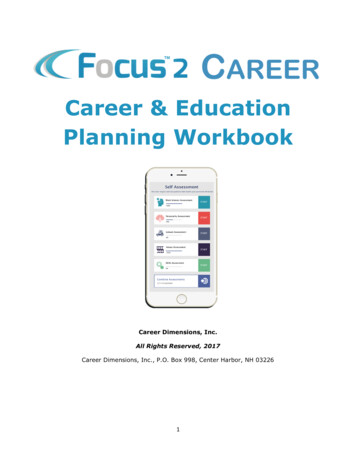
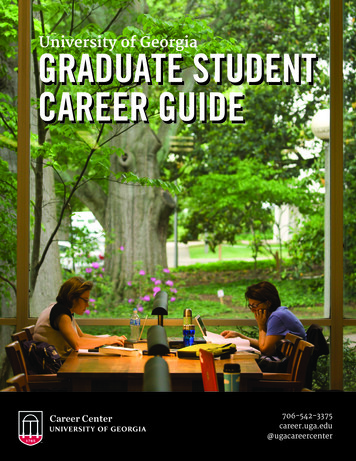

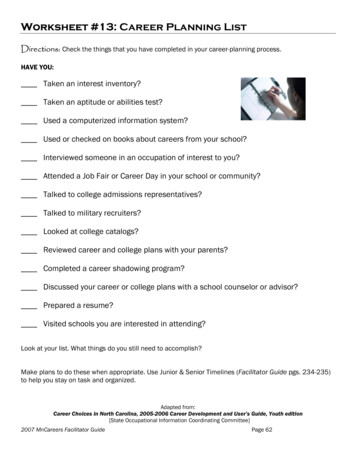
![05[2] Strategy competitors, competitive rivalry .](/img/2/052-strategy-competitors-competitive-rivalry-competitive-behavior-and-competitive-dynamics.jpg)
